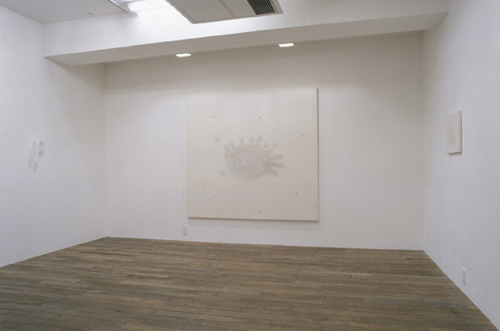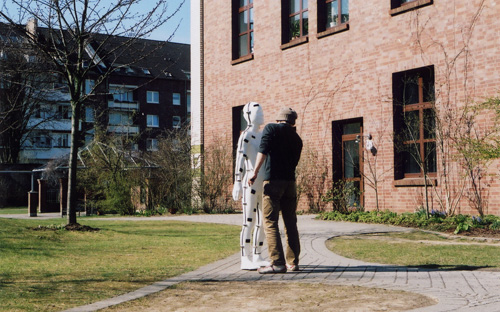"skin"
My Production Method: A Study Concerning the Interface "Skin"
My recent works have been created under the objective of considering our existence via a "skin," which acts as a boundary between the external world and the individual. In my view, the existence of a "skin" is like a membrane that filters our memories. It also acts as a boundary for us to take in views of the external world. Thus, the method of my artistic production is based on the amplitudes that occur in the process of filtering or incorporating memories and views "from the body to the external world" and "from the external to the internal."The production of my two-dimensional works, entitled "Mole" and "Freckle," is based on a process similar to tracing my memories "backwards." First of all, I make a drawing of the motif I have in mind. Based on this drawing, I look for photos that possess similar images and elements. I manipulate these photos by combining, modifying, composing and revising them on a computer. This process is undertaken so that the images can come closer to the image found in my drawing. What is manifested through this process is something like a merged form of the drawing and the photographic images. I combine the samplings of the elements I obtained by going through that process several times, then depict them on a canvas. I feel that the depiction on the canvas represents the emergence of a different form than the original subject I made in the initial drawing, which was the subject that motivated me into creating that drawing. It also represents the emergence of a transformed form which I unconsciously came to recognize. For the final steps, I envelop the work in fake skin by stretching a cotton cloth over the image on the canvas. I then depict stain-like shapes of moles and freckles, and finally cover the entire canvas with wax. Through this process, the image can once again be returned to an intangible interior.
My process that fixes the fragments of my unclear memories and images as they exist naturally onto the canvas can become a method to express the interface itself, which is the border between the world (the external) and the body (the internal).
Contrarily, perhaps we should ask ourselves how the world we live in would look if we were to look at it from an objective point of view. For instance, how do the information and sensations we receive from the external world exist within us before they are fixed in our minds as memories and recognitions? What is "pure sensation" like, which our bodies receive from the external world? Needless to say, it is almost impossible for us to even imagine or think about those states. Since our actions of "looking" and "feeling" can never escape being bound by "recognition," which is controlled by subjectivity.
Therefore, I also aimed to create a type of device (of course, this should be seen in a symbolic sense) that can purely take in the world at the point at which the body comes in contact with it; that is, a device that can take in a form before it changes to memory, without undergoing the "imagining" and "thinking" processes. My mind was strictly set on manifesting before one's eyes the existence that simply and purely reflects "the external." My work entitled "skin hole - skin sense" is a life-sized camera obscura; my body acts as the model. On various parts of the surface, I opened holes to resemble pores, which functioned as pinhole lenses. Utilizing the basic principle of camera obscura, this work attempted to fix the external world that is projected on the inside onto film and photographic paper.
Needless to say, whether or not there ever existed a photographic conductor, such as film, the external world would be ceaselessly projected onto the inside of "his body" in my work "skin hole - skin sense." In my view, "his body," which has escaped a subjective point of view, can act as a symbolic existence that can cast an objective point of view in between a person and the world.
In the former type of work described above, I start by creating an "internal" image (drawing), then bring in similar "external" images (photos and film) closer to that "internal" image, and then finally, cover the entire work with a fake skin (wax). In this way, I can approach viewers by showing them the state of the boundary surface that exists between memory (the internal) and reality (the external). But in the latter type of work, the question "What is an objective 'external'?" is elicited through the symbolic act of the pinhole lenses made on the entire surface of "the skin," which continuously take in pure "external" information. These two types of works are considered from opposite viewpoints: one from the internal to the external, and the other, from the external to the internal, both through the filter of the "skin." Both types of works can act as tools in considering the boundary line that exists between "the internal" and "the external." Utilizing these tools, I seek possibilities for my work to become the axis through which one can recognize one's existence that exists in between "the internal" and "the external."
Nobuyuki Osaki
Catalogue of Nobuyuki OSAKI solo exhibition “Cutaneous Respiration, 2003
The copyright in these pictures and captions etc, are owened by Nobuyuki OSAKI.
No part of these works may be reproduced or transmitted in any form or by any means without the written permission of Nobuyuki OSAKI


